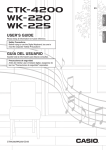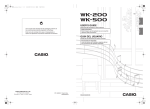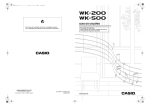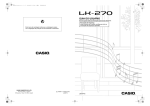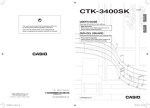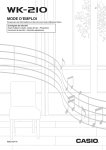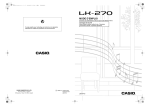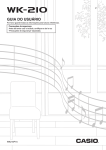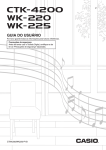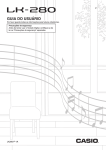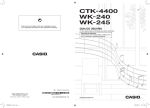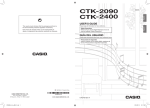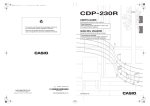Download Casio Keyboard WK200 User's Manual
Transcript
WK200_e_cov1-2.fm 1 ページ 2008年10月6日 月曜日 午後3時36分 English ES USER’S GUIDE Safety Precautions Before trying to use the keyboard, be sure to read the separate “Safety Precautions”. GUÍA DEL USUARIO Guarde toda la información para futuras consultas. Precauciones de seguridad Antes de intentar usar el teclado, asegúrese de leer las “Precauciones de seguridad” separadas. WK200/500ES1B Español Please keep all information for future reference. WK200_e_cov1-2.fm 2 ページ 2008年10月6日 月曜日 午後3時36分 NOTICE This equipment has been tested and found to comply with the limits for a Class B digital device, pursuant to Part 15 of the FCC Rules. These limits are designed to provide reasonable protection against harmful interference in a residential installation. This equipment generates, uses and can radiate radio frequency energy and, if not installed and used in accordance with the instructions, may cause harmful interference to radio communications. However, there is no guarantee that interference will not occur in a particular installation. If this equipment does cause harmful interference to radio or television reception, which can be determined by turning the equipment off and on, the user is encouraged to try to correct the interference by one or more of the following measures: • Reorient or relocate the receiving antenna. • Increase the separation between the equipment and receiver. • Connect the equipment into an outlet on a circuit different from that to which the receiver is connected. • Consult the dealer or an experienced radio/TV technician for help. FCC WARNING Changes or modifications not expressly approved by the party responsible for compliance could void the userís authority to operate the equipment. Declaration of Conformity Model Number: WK-200/WK-500 Trade Name: CASIO COMPUTER CO., LTD. Responsible party: CASIO AMERICA, INC. Address: 570 MT. PLEASANT AVENUE, DOVER, NEW JERSEY 07801 Telephone number: 973-361-5400 This device complies with Part 15 of the FCC Rules, Operation is subject to the following two conditions: (1) This device may not cause harmful interference, and (2) this device must accept any interference received, including interference that may cause undesired operation. WK200_e.book 1 ページ 2008年5月16日 金曜日 午後8時44分 Important! • Before using the optional AC Adaptor to power the unit, be sure to check the AC Adaptor for any damage first. Carefully check the power cord for breakage, cuts, exposed wire and other serious damage. Never let children use an AC adaptor that is seriously damaged. • Never attempt to recharge batteries. • Do not use rechargeable batteries. • Never mix old batteries with new ones. • Use recommended batteries or equivalent types. • Always make sure that positive (+) and negative (–) poles are facing correctly as indicated near the battery compartment. • Replace batteries as soon as possible after any sign they are getting weak. • Do not short-circuit the battery terminals. • The product is not intended for children under 3 years. • Use only a CASIO AD-5 (for WK-200) or AD-12 (for WK-500) adaptor. • The AC adaptor is not a toy. • Be sure to disconnect the AC adaptor before cleaning the product. This mark applies in EU countries only. Manufacturer: CASIO COMPUTER CO.,LTD. 6-2, Hon-machi 1-chome, Shibuya-ku, Tokyo 151-8543, Japan Responsible within the European Union: CASIO EUROPE GmbH Bornbarch 10, 22848 Norderstedt, Germany ● Company and product names used in this manual may be registered trademarks of others. ● Any reproduction of the contents of this manual, either in part or its entirety, is prohibited. Except for your own, personal use, any other use of the contents of this manual without the consent of CASIO is prohibited under copyright laws. ● IN NO EVENT SHALL CASIO BE LIABLE FOR ANY DAMAGES WHATSOEVER (INCLUDING, WITHOUT LIMITATION, DAMAGES FOR LOSS OF PROFITS, BUSINESS INTERRUPTION, LOSS OF INFORMATION) ARISING OUT OF THE USE OF OR INABILITY TO USE THIS MANUAL OR PRODUCT, EVEN IF CASIO HAS BEEN ADVISED OF THE POSSIBILITY OF SUCH DAMAGES. ● The contents of this manual are subject to change without notice. E-1 English Please note the following important information before using this product. WK200_e.book 2 ページ 2008年5月16日 金曜日 午後8時44分 Contents General Guide ............................. E-4 Playing Built-in Songs.............. E-25 Using the 10-key Pad (bs) .................................E-6 FUNCTION Button (ct) Functions .....................E-6 Playing the Demo Songs ................................. E-25 Playing Back a Particular Song........................ E-26 Increasing the Selection of Songs ................... E-28 Getting Ready to Play ................ E-8 Preparing the Music Stand .................................E-8 Power Supply .....................................................E-8 Playing the Digital Keyboard ..... E-9 Turning on Power and Playing ...........................E-9 Using Headphones .............................................E-9 Changing Keyboard Response to Touch Pressure (Touch Response)..................E-10 Adjusting Display Contrast ...............................E-10 Using Built-in Songs to Master Keyboard Play .............. E-29 Phrases............................................................ E-29 Step Up Lesson Flow....................................... E-29 Selecting the Song, Phrase, and Part You Want to Practice................................ E-30 Lessons 1, 2, and 3.......................................... E-31 Lesson Settings ............................................... E-32 Using Auto Step Up Lesson............................. E-34 Using the Metronome .......................................E-11 Controlling the Keyboard Sounds ..................... E-12 Select from a variety of musical instrument sounds ...............................E-12 Layering Two Tones .........................................E-13 Splitting the Keyboard between Two Different Tones .........................................E-13 Using Reverb....................................................E-14 Using Chorus....................................................E-14 Using a Pedal ...................................................E-15 Changing the Pitch (Transpose, Tuning, Octave Shift)....................E-15 Using the Pitch Bend Wheel to Shift the Pitch of Notes (WK-500 Only) ..........................E-16 Sampling Sounds and Playing Them on the Digital Keyboard ....................... E-17 Connection and Preparation.............................E-17 Sampling and Playing a Melody Sound (Melody Sampling) ...........................................E-18 Incorporating a Sampled Sound into a Drum Set (Drum Sampling) ..............................E-20 Other Sampling Functions ................................E-22 Music Challenge Keyboard Game ........................ E-35 Using Auto Accompaniment.... E-36 Playing the Rhythm Part Only.......................... E-36 Playing All Parts............................................... E-37 Using Auto Accompaniment Effectively ........... E-39 Using One-Touch Preset ................................. E-40 Using Auto Harmonize ..................................... E-41 Editing Auto Accompaniment Patterns...................................... E-42 Saving Keyboard Setups to Registration Memory ................ E-46 To save a setup to registration memory........... E-47 To recall a setup from registration memory ..... E-47 Recording Your Keyboard Play ........................... E-48 Recording and Playing Back Keyboard Play ... E-48 Using Tracks to Record and Mix Parts ............ E-49 Recording Two or More Songs, and Selecting One for Playback.............................. E-51 Recording while Playing Along with a Built-in Song..................................................... E-51 Saving Recorded Data on an External Device................................................ E-52 E-2 WK200_e.book 3 ページ 2008年5月16日 金曜日 午後8時44分 Contents Reference................................... E-70 Troubleshooting ............................................... E-70 Specifications................................................... E-72 Changing the Scale of the Keyboard................E-53 Using Music Preset ..........................................E-56 Operating Precautions ..................................... E-73 Error Messages................................................ E-74 Using the Arpeggiator.......................................E-56 Deleting User Song Data..................................E-57 Deleting All Data in Digital Keyboard Memory ............................................................E-58 Song List .......................................................... E-75 MIDI Implementation Chart Using a Memory Card (WK-500 Only) ........................... E-59 SD Memory Card and Card Slot Precautions ......................................................E-59 Inserting and Removing an SD Memory Card..............................................E-60 Formatting an SD Memory Card.......................E-60 Saving Digital Keyboard Data to an SD Memory Card..............................................E-61 Loading Data from an SD Memory Card into Digital Keyboard Memory ..........................E-62 Deleting Data from an SD Memory Card..........E-63 Playing Back Data from an SD Memory Card..............................................E-64 SD Memory Card Error Messages ...................E-64 Connecting External Devices ...................................... E-65 Connecting a Computer ...................................E-65 MIDI Settings....................................................E-66 Storing and Loading Digital Keyboard Memory Data....................................................E-68 Connecting to Audio Equipment.......................E-69 Included Accessories Separately Available Accessories ● Music Stand ● Song Book ● Leaflets • Safety Precautions • Appendix • Other (Warranty, etc.) Items included as accessories are subject to change without notice. • You can get information about accessories that are separately for this product from the CASIO catalog available from your retailer, and from the CASIO website at the following URL. http://world.casio.com/ E-3 English Other Useful Digital Keyboard Functions .................................. E-53 WK200_e.book 4 ページ 2008年5月16日 金曜日 午後8時44分 General Guide • In this manual, the term “Digital Keyboard” refers to the WK-200/WK-500. • Illustrations in this User’s Guide show the WK-500. • In this manual, buttons and other controllers are identified using the numbers shown below. 2 1 3 8 9 bk bl bm bn 4 5 6 7 bo bs bp bq br bt ck cl cm cn co dl dr E-4 ds dm dt dn do dp cp cq cr dq cs ct dk dl ek WK200_02_e.fm 5 ページ 2008年5月19日 月曜日 午後7時14分 General Guide POWER button ☞E-9, 24, 44, 47, 49, 55, 68 5 6 7 8 9 RECORDER button ☞E-48, 49, 50, 51, 52 ck Area1, TR2, WATCH button ☞E-19, 31, 46, 47, 50, 55 MAIN VOLUME knob ☞E-9 cl Area2, TR3, REMEMBER button MIC VOLUME knob ☞E-17 ☞E-19, 32, 46, 47, 50, 55 PRESET SCALE button (WK-200) SCALE EDITOR button (WK-500) ☞E-53, 54, 55 RHYTHM EDITOR button ☞E-42, 43 ☞E-19, 35, 47, 50, 55 METRONOME, BEAT button ☞E-11 INTRO, REPEAT button ☞E-27, 32, 39, 42, 43 NORMAL/FILL-IN, REW button ☞E-26, 30, 36, 39, 42, 43 cs SAMPLING button ☞E-18, 19, 20, 21 ct FUNCTION button ☞E-6 dk CARD, SAVE/LOAD button (WK-500 only) ☞E-26, 30, 39, 42, 43 bl SYNCHRO/ENDING, PAUSE button ☞E-26, 39, 40, 42, 43 ☞E-60, 61, 62, 63, 64 bm START/STOP, PLAY/STOP button ☞E-25, 26, 28, 31, 32, 36, 48, 50, 51, 52, 64 bn ACCOMP ON/OFF, CHORDS, PART SELECT button ☞E-25, 28, 30, 32, 37, 41, 42, 43, 52, 67 bo TEMPO buttons ☞E-11, 27, 40 bp TONE, MUSIC PRESET button ☞E-9, 12, 18, 20, 21, 22, 24, 56 bq RHYTHM, ONE TOUCH PRESET button ☞E-12, 19, 20, 22, 36, 40, 43, 47, 48, 51, 55 br SONG BANK button ☞E-26, 28, 30, 51 bs Number buttons, [–]/[+] buttons ☞E-6 bt BANK, CHORD/TR1, LISTEN button ☞E-19, 31, 46, 47 el USB port ☞E-65 em SUSTAIN/ASSIGNABLE JACK ☞E-15 en PHONES/OUTPUT jack (WK-200) PHONES jack (WK-500) ☞E-9, 69 eo AUDIO IN jack ☞E-17, 69 cp SPLIT button ☞E-13, 14 cq LAYER button ☞E-13, 16 cr AUTO HARMONIZE/ARPEGGIATOR, TYPE button ☞E-41, 56, 57 bk VARIATION/FILL-IN, FF button el cm Area3, TR4, NEXT button ☞E-19, 30, 46, 47, 50, 55 cn Area4, TR5, AUTO button ☞E-19, 34, 46, 47, 50, 55 co STORE, TR6, MUSIC CHALLENGE button em dl Speakers dm Song Bank list dn Music Preset list do Display dp Rhythm list dq Tone list dr PITCH BEND wheel (WK-500 only) ☞E-16 ds CHORD root names ☞E-37 dt Percussion instrument list ☞E-12 ek SD CARD SLOT (WK-500 only) ☞E-60 en eo ep eq er ep DC 9V terminal (WK-200) DC 12V terminal (WK-500) ☞E-8 eq MIC IN jack ☞E-17 er LINE OUT R, L/MONO jack (WK-500 only) ☞E-69 E-5 English 1 2 3 4 WK200_02_e.fm 6 ページ 2008年5月19日 月曜日 午後7時14分 General Guide Using the 10-key Pad (bs) Use the number buttons and the [–] and [+] buttons to change the settings of the parameters that appear in the upper left area of the display. FUNCTION Button (ct) Functions You can use the FUNCTION button (ct) to adjust the reverb effect, to delete data, and to perform a wide range of other Digital Keyboard operations. To select a function 1. Press ct to display the function menu. 2. Use the bs (10-key) [4] ( ) and [6] ( to display the function you want. Setting S t .GrPno Number Buttons Use the number buttons to enter numbers and values. • Enter the same number of digits as the currently displayed value. Example: To enter tone number 001, input 0 3 0 3 1. • Negative values cannot be input using the number buttons. Use [–] (decrease) and [+] (increase) instead. [–] and [+] Buttons You can use the [–] (decrease) and [+] (increase) buttons to change the displayed number or value. • Holding down either button scrolls the displayed setting. • Pressing both buttons at the same time will revert to the initial default setting or the recommended setting. E-6 ) keys • You can exit the function menu by pressing ct. • After selecting functions 8 through 12, press the bs (10-key) [7] (ENTER) key to display the menu item’s submenu. Then use [4] ( ) and [6] ( ) to select an item. You can exit a submenu by pressing the bs (10-key) [9] (EXIT) key. 3. Refer to the indicated pages for details about each function. WK200_02_e.fm 7 ページ 2008年5月19日 月曜日 午後7時14分 General Guide Display See Page 1 Transpose Trans. 2 Accompaniment Volume AcompVol E-40 3 Song Volume Song Vol E-28 4 Touch Response Touch E-10 5 Tuning Tune E-15 6 Reverb Reverb E-14 7 Chorus Chorus E-14 8 Sampling SAMPLING Automatic Sampling Start AutoStrt Automatic Sampling Stop AutoStop E-23 Sampled Tone Protect (Protect) E-24 9 E-15 E-22 Step Up Lesson LESSON Voice Fingering Guide Speak Note Guide NoteGuid E-33 Performance Evaluation Scoring E-33 PhraseLn E-33 Phrase Length 10 Other Settings E-32 OTHER Arpeggiator Hold ArpegHld E-57 Pedal Effect Jack E-15 Pitch Bend Range (WK-500 only) Bend Rng E-16 Accompaniment Scale AcompScl E-55 LCD Contrast Contrast E-10 11 MIDI Settings MIDI Keyboard Channel Keybd Ch E-66 Navigate Channels Navi. Ch E-66 Local Control Local E-67 Accomp Out AcompOut E-67 12 Delete English Function DELETE Sampled Sound Delete (tone name) User Rhythm Delete (rhythm name) E-45 E-23 User Song Delete (song name) E-57 All Data Delete All Data E-58 • The tone and other parameters revert to their initial defaults whenever you turn on power (page E-9). E-7 WK200_02_e.fm 8 ページ 2008年5月19日 月曜日 午後7時14分 Getting Ready to Play Preparing the Music Stand Music stand Using Batteries • Be sure to turn off power before loading batteries. • It is up to you to prepare six commercially available D-size batteries. Do not use oxyride batteries or any other nickel based batteries. 1. Open the battery cover on the bottom of the Digital Keyboard. Power Supply Either an AC adaptor or batteries can be used to power this Digital Keyboard. Normally, use of AC adaptor power is recommended. • The AC adaptor does not come with this Digital Keyboard. Purchase it separately from your retailer. See page E-3 for information about options. 2. Load six D-size batteries into the battery compartment. Make sure the positive + and negative - ends of the batteries are facing as shown in the illustration. Using the AC Adaptor Use the AC adaptor when you want to power the Digital Keyboard from a household electrical outlet. Specified AC Adaptor: AD-5 (WK-200) AD-12 (WK-500) DC 9V terminal (WK-200) DC 12V terminal (WK-500) AC adaptor 3. Insert the tabs of the battery cover into the holes on the side of the battery compartment, and close the cover. Tabs Household power outlet • Be sure to turn off Digital Keyboard power before connecting or disconnecting the AC adaptor. ■ Low Battery Indication The indicator shown below starts to flash to let you know when battery power is low. Replace the batteries with new ones. Low battery indicator (flashes) E-8 WK200_02_e.fm 9 ページ 2008年5月19日 月曜日 午後7時14分 21 7 Turning on Power and Playing 1. Press 1. This turns on power. 2. Try playing something on the keyboard. Use 2 to adjust volume. bs bp bo English Playing the Digital Keyboard ct Using Headphones Using headphones cuts off output from the built-in speakers, which means you can practice playing even late at night without disturbing others. • Be sure to turn down the volume level before connecting headphones. PHONES/OUTPUT jack (WK-200) PHONES jack (WK-500) Decrease Increase • Turning off the Digital Keyboard causes most current settings to be cleared. The Digital Keyboard will revert to initial settings the next time you turn it on. • This is true for all settings except for sample sound protection. Once you turn it on it remains on until you turn it off again. • Headphones do not come with the Digital Keyboard. • Use commercially available headphones. See page E-3 for information about options. • Do not listen to very high volume output over headphones for long period. Doing so creates the risk of hearing damage. • If you are using headphones that require an adaptor plug, make sure you do not leave the adaptor plugged in when removing the headphones. Auto Power Off (Using Batteries) While you are using batteries for power, power will turn off automatically if you do not perform any operation for about six minutes. Auto Power Off is disabled while the AC adaptor is being used for power. ■ Disabling Auto Power Off You can disable Auto Power Off to ensure that power is not turned off automatically during a concert, etc. 1. While holding down bp, turn on power. Auto Power Off will be disabled. E-9 WK200_e.book 10 ページ 2008年5月16日 金曜日 午後8時44分 Playing the Digital Keyboard Changing Keyboard Response to Touch Pressure (Touch Response) Touch Response alters tone volume in accordance with keyboard pressure (speed). This provides you some of the same expressivity you get on an acoustic piano. Changing Touch Response Sensitivity Use the procedure below to control how much the volume of played notes change in accordance with playing speed. Select the setting that best matches your playing style. 1. Press ct and then use the bs (10-key) [4] ( and [6] ( E-6). ) ) keys to display “Touch” (page Keyboard Instrument Sound Intensity Touch ■ Sound intensity depends on the speed that keys are pressed. People normally believe that the stronger the pressure applied to a piano keyboard, the louder the sound. Actually, however, the intensity of the notes played depends on the speed at which keys are pressed. Notes are louder when keys are pressed quickly, and quieter when keys are pressed slowly. Keeping this in mind as you play a keyboard musical instrument lets you control note volume without striving to apply too much pressure with your fingertips. ■ The playability of an acoustic piano 2. Use bs (10-key) [–] and [+] keys to select one of the three Touch Response sensitivity settings. Off (oFF) Touch Response is turned off. Sound volume is fixed, regardless of key press speed. Type 1 (1) Normal Touch Response Type 2 (2) More sensitive Touch Response than Type 1 Your Digital Keyboard provides you with key touch that is the next best thing to an acoustic piano. Note volume changes automatically in accordance with key press speed. Pressing fast produces louder notes. Indicator disappears when Touch Response is turned off. Adjusting Display Contrast 1. Press ct and then use the bs (10-key) [4] ( and [6] ( E-6). Pressing slowly produces softer notes. ) ) keys to display “OTHER” (page Flashes OTHER Do not try to use too much pressure. 2. Press bs (10-key) [7] (ENTER) key. 3. Use the bs (10-key) [4] ( ) and [6] ( ) keys to display “Contrast”. Con t r as t 4. Use the bs (10-key) [–] and [+] keys to adjust the contrast. • The contrast setting range is 01 to 17. E-10 WK200_e.book 11 ページ 2008年5月16日 金曜日 午後8時44分 Playing the Digital Keyboard The metronome lets you play and practice along with a steady beat to help keep you on tempo. Changing the Metronome Tempo Use the following procedure to change the tempo of the metronome. 1. Press bo. Start/Stop 1. Press 7. This starts the metronome. This pattern changes with each beat. Use y (slower) and t (faster) to change the tempo setting. Holding down either button changes the setting at high speed. • Pressing t and y at the same time will initialize the tempo setting in accordance with the currently selected song or rhythm. • Pressing bo causes the tempo value to flash on the display. While the tempo value is flashing, you can use bs (10-key) to change it. Note that you must input leading zeros, so 89 is input as 089. • The tempo value will stop flashing if you do not perform any operation for a short while. 2. Press 7 again to stop the metronome. Changing the Beats Per Measure Tempo value (flashes) You can configure the metronome to use a bell sound for the first beat of each measure of the song you are playing. • You can specify 0, or a value from 2 to 6 as the number of beat per measure. • When playing a built-in song, the beats per measure setting (which determines when the bell sounds) is configured automatically for the currently selected song. 1. Hold down 7 until the beats per measure setting screen appears on the display. Bea t • If you do not perform any operation for a few seconds after the beats per measure setting screen appears, the display will return to the screen displayed before you pressed 7. Changing the Metronome Sound Volume The metronome volume setting is changed automatically with the volume level of the currently selected Auto Accompaniment or song. The metronome volume cannot be adjusted independently. • For information about changing the Auto Accompaniment volume, see page E-40. • For information about changing the song volume, see page E-28. • You cannot adjust the balance between the metronome and note volume during Auto Accompaniment and built-in tune play. 2. Use bs (10-key) to enter the number of beats per measure. • The bell will not sound if you specify 0 for this setting. In this case, all beats are indicated by a click sound. This setting lets you practice with a steady beat, without worrying how many beats there are in each measure. E-11 English Using the Metronome WK200_e.book 12 ページ 2008年5月16日 金曜日 午後8時44分 Controlling the Keyboard Sounds bs bqbp cp cq Select from a variety of musical instrument sounds ct 3. Try playing something on the keyboard. The tone of the instrument you selected will sound. Your Digital Keyboard lets you select tones for a wide variety of musical instrument sounds, including violin, flute, orchestra, and more. Even the same song sound takes on a different feel by changing the instrument type. To select an instrument for playing 1. Press bp. Tone number Tone name S t .GrPno 2. Use bs (10-key) to select the tone number you want. The corresponding tone number and tone name will appear on the screen. • See the separate “Appendix” for a complete list of available tones. • Use the number buttons to enter the tone number. Specify three digits for the tone number. Example: To select 001, enter 0 3 0 3 1. • When one of the drum sets is selected, each keyboard key is assigned a different percussion sound. E-12 Playing with a Piano Tone (Piano Setup) 1. Press bp and bq at the same time. This selects the grand piano tone. Settings Tone Number Reverb Transpose Touch Response : “001” : “06” : 00 : Off: Returns to initial default On: No change Pedal Effect : SUS Rhythm Number : “161” (WK-200), “181” (WK-500) Accompaniment : Rhythm part only Local Control : On Drum Assign : Off Split : Off Layer : Off Chorus : Off Octave Shift (Upper) : 0 Auto Harmonize : Off Arppegiator : Off Scale : Equal WK200_e.book 13 ページ 2008年5月16日 金曜日 午後8時44分 Layering Two Tones You can use the following procedure to layer two different tones (such as piano and strings) so they sound simultaneously when you press a keyboard key. 1. Select the first tone you want to use. Press bp and then use bs (10-key) to select the tone you want. Example: 026 ELEC.PIANO 1 (WK-500) E.Pi ano1 Splitting the Keyboard between Two Different Tones You can use the procedure below to assign different tones to the right range and left range of the keyboard, so it sounds like you are playing an ensemble between two instruments. To select the two tones for a split keyboard 1. Select the tone for the right side range (page E-12). Press bp and then use bs (10-key) to select the tone you want. Example: 335 FLUTE 1 (WK-500) 2. Press cq. F l u t e 1 2. Press cp. Lights 3. Use bs (10-key) to select the second tone you want. Example: 212 STRINGS (WK-500) St r i n Lights g s 3. Use bs (10-key) to select the left side range tone you want. Example: 056 VIBRAPHONE 1 (WK-500) 4. Play something on the keyboard. Vi bes Both tones sound at the same time. 1 5. Pressing cq again to unlayer the keyboard (so it plays only the tone you selected in step 1). • Each press of cq toggles between layered (two tones) and unlayered (one tone). 4. Play something on the keyboard. This will sound the tones assigned to the left and right side ranges of the keyboard. VIBRAPHONE 1 FLUTE 1 Split point Disappears F3 E-13 English Controlling the Keyboard Sounds WK200_e.book 14 ページ 2008年5月16日 金曜日 午後8時44分 Controlling the Keyboard Sounds 5. Pressing cp again to unsplit the keyboard (so it plays only the tone you selected in step 1). • Each press of cp toggles between split (two tones) and unsplit (one tone). Using Reverb Reverb adds reverberation to notes. You can change the duration of the reverb. 1. Press ct and then use the bs (10-key) [4] ( and [6] ( E-6). Reve r b Disappears • If you turn on both layer and split, layering will be applied to the right side range of the keyboard only. To change the split point ) ) keys to display “Reverb” (page 2. Use the bs (10-key) [–] and [+] keys to select the reverb setting you want. Off (oFF) Turns off reverb. 1 to 10 The larger the number selected, the longer the reverb duration. 1. While holding down cp, press the keyboard key where you want the split point to be. The key you press will become the lowest note of the right side range of the split keyboard. Example: Setting middle C (C4) as the split point. Reve r b Key name C 4 Indicator disappears when reverb is turned off. Using Chorus Chorus is a function that adds depth and breadth to notes. It makes you sound as if you are playing multiple instruments. 1. Press ct and then use the bs (10-key) [4] ( and [6] ( E-6). ) ) keys to display “Chorus” (page Cho r us 2. Use the bs (10-key) [–] and [+] keys to select the chorus type you want. There are five chorus types, plus an off setting. Cho r us Indicator disappears when chorus is turned off. • The actual effect produced by chorus depends on the tone you are using. E-14 WK200_02_e.fm 15 ページ 2008年5月19日 月曜日 午後7時14分 Using a Pedal A pedal can be used to change notes in various ways while playing. • A pedal unit does not come with the Digital Keyboard. Purchase one separately from your retailer. See page E-3 for information about options. Changing the Pitch (Transpose, Tuning, Octave Shift) Changing the Pitch in Semitone Steps (Transpose) The transpose feature lets you change the pitch, in semitone steps. A simple operation lets you instantly change the pitch to match that of a singer. • The transpose setting range is –12 to +12 semitones. Connecting a Pedal Unit Connect an optional pedal unit. SUSTAIN/ASSIGNABLE JACK 1. Press ct. Trans . 2. Use the bs (10-key) [–] and [+] keys to select the transpose setting you want. Selecting the Pedal Effect 1. Press ct and then use the bs (10-key) [4] ( and [6] ( E-6). ) ) keys to display “OTHER” (page Flashes OTHER Fine Tuning (Tuning) Use the tuning feature when you need to adjust the pitch slightly to play along with another musical instrument. Also, some artists perform their music with slightly altered tuning. You can use the tuning feature to adjust tuning so it exactly matches a performance on a CD. • The tuning setting range is –99 to +99 cents. 1. Press ct and then use the bs (10-key) [4] ( and [6] ( ) ) keys to display “Tune” (page E-6). 2. Press bs (10-key) [7] (ENTER) key. 3. Use the bs (10-key) [4] ( ) and [6] ( Tune ) keys to display “Jack”. Jack 2. Use the bs (10-key) [–] and [+] keys to adjust the tuning. 4. Use the bs (10-key) [–] and [+] keys to select the pedal effect you want. • The following shows the available pedal effects. Sustain (SUS) Sustains notes played while the pedal is depressed. Organ and other similar tone notes are sustained even if the pedal is not pressed. Sostenuto (SoS) Sustains notes that are playing when the pedal is depressed before the keyboard keys are released. Soft (SFt) Slightly softens notes played while the pedal is depressed. Rhythm (rHy) Pressing the pedal starts and stops Auto Accompaniment or song playback. E-15 English Controlling the Keyboard Sounds WK200_02_e.fm 16 ページ 2008年5月19日 月曜日 午後7時14分 Controlling the Keyboard Sounds Octave Shift Octave Shift lets you raise or lower the pitch of the keyboard notes in octave units. • The octave shift setting range is –2 to +2 octaves. • When using Split (page E-13), you can individually set the left and right keyboard ranges to the pitches you want. 1. Keep pressing cq until the screen shown below appears on the display. If you want to use Split, turn on Split before pressing cq. • If you do not perform any operation for a few seconds after this screen appears, the display will return to the previous screen automatically. Oc t U p p er 2. Use the bs (10-key) [–] and [+] keys to shift the octave. • Split On : This step affects the right side keyboard range only. • Split Off : This step affects the entire keyboard range. 3. Press cq. • Split On : The screen shown below will appear. Use the bs (10-key) [–] and [+] keys to shift the octave for the left side keyboard range. • Split Off : The screen shown below will appear. Advance to step 4. Using the Pitch Bend Wheel to Shift the Pitch of Notes (WK-500 Only) You can use the pitch bend wheel to slide the pitch of notes smoothly upwards and downwards. This technique makes it possible to produce effects that are similar to sounds produced when bending notes on a saxophone or electric guitar. To play with the pitch bend wheel 1. While playing a note on the keyboard, rotate the pitch bend wheel on the left of the keyboard upwards or downwards. The amount the note bends depends on how much you rotate the pitch bend wheel. • Do not have the pitch bend wheel rotated as you turn on the Digital Keyboard. Specifying the Pitch Bend Range Use the following procedure to specify how much the pitch of the note changes whenever the pitch bend wheel is rotated upwards or downwards. You can specify a range from 0 to 12 semitones (one octave). 1. Press ct and then use the bs (10-key) [4] ( and [6] ( E-6). Oc t Lowe r ) ) keys to display “OTHER” (page Flashes OTHER 4. Press cq again. 2. Press bs (10-key) [7] (ENTER) key. 3. Use the bs (10-key) [4] ( ) and [6] ( ) keys to display “Bend Rng”. Bend Rn g 4. Use the bs (10-key) [–] and [+] keys to change the range. E-16 WK200_02_e.fm 17 ページ 2008年5月19日 月曜日 午後7時14分 1 3 bqbp bt ck cl cm cn co You can sample a sound from a microphone, a portable audio player, or other device, and then play the sound on the keyboard. For example, you could sample the bark of your dog and then use the sound in a melody. You also can sample and use passages from a CD. The sampling feature is a great way to create new sounds that are highly creative. Connection and Preparation • Before connecting, make sure that the Digital Keyboard, external devices, and/or the microphone all are turned off. English Sampling Sounds and Playing Them on the Digital Keyboard bs cs ct 2. Turn down the volume levels of the external device and the Digital Keyboard. 3. Turn on the external device or microphone, and then turn on the Digital Keyboard. • When using a microphone, adjust the input volume level with 3. • It will take a few seconds after you turn on the Digital Keyboard before you will be able to use the microphone. • Sampled sounds are recorded in monaural. 1. Connect a microphone or external device to the Digital Keyboard. MIC IN jack Digital Keyboard AUDIO IN jack CD player, Cassette player, etc. Stereo mini plug • You also could connect a commercially available microphone. • Connection of an external device requires commercially available connecting cords, supplied by you. Connecting cords should have a stereo mini plug on one end and a plug that matches the configuration of the external device on the other end. E-17 WK200_e.book 18 ページ 2008年5月16日 金曜日 午後8時44分 Sampling Sounds and Playing Them on the Digital Keyboard Sampling and Playing a Melody Sound (Melody Sampling) Use the procedures in this section to sample a sound and play it as the melody part on the Digital Keyboard. • Up to five sampled sounds can be stored in Digital Keyboard memory as tone numbers 671 through 675 (WK200: 571 through 575). Simply select the tone number where the sound you want is located to assign the sound to the keyboard. 4. After the sound you want to sample is finished, press cs. Sampling will stop when you release cs. • Even if you do not press cs, sampling will stop automatically whenever there is no more sound being input from the external device or microphone. Sampling also will stop automatically 10 seconds after it is started. Sampled sound 1 S1 :Or To sample a sound g n l 1. Press bp and then use bs (10-key) to enter the tone number (WK-500: 671 to 675) (WK-200: 571 to 575) where you want to store the sampled sound. No Da t a Lights • In place of the above steps, you could press cs and bp at the same time and then select a tone number. 2. Press cs. This enters sampling standby. The allowable sampling time (in seconds) will appear on the display momentarily and then the display will change to the following. g Flashes 3. Output the sound from the external device. In the case of a microphone, output the sound in the direction of the microphone. Sampling will start automatically. Samp l i n Lights E-18 Remaining memory capacity 5. Play something on the Digital Keyboard. No sampled sound stored Wa i t i n Used memory (Unit: Kbytes) g • You may not be able to get 10 seconds of sampling if Digital Keyboard memory is low due to storage of other data. If this happens, deleting other memory data you no longer need will free up memory space and you should be able to sample for 10 seconds. See “Deleting a Sampled Sound” on page E-23 for more information. • Sampling sound and storing it will delete any sound data currently stored under the same tone number. To help ensure that you do not accidentally delete important data, be sure to read “Protecting Against Accidental Deletion of Sampled Sounds” on page E-24. WK200_e.book 19 ページ 2008年5月16日 金曜日 午後8時44分 Sampling Sounds and Playing Them on the Digital Keyboard Pressing Middle C (C4) will play back the original sound. The keys to the left and right of C4 play the sound at different pitches. Changing the Volume of Sampled Sound Looped Playback You can use the following procedure to change the volume level of the looped playback of each sampled sound, if you want. 1. Press the button of the sampled sound whose volume you want to change (bt to cn). • This will cause the sounds loop to sound. C4 2. While the loop is sounding hold down the same sampled sound button (bt to cn) as you press Looping a Sampled Sound You can use the following procedure to loop a sampled sound so it continues to repeat, as you play on the Digital Keyboard. 1. Press bq. 2. While holding down cs, press co. • Pressing the keyboard key quickly will increase sample sound volume, while pressing slowly will decrease volume. 3. After the sampled sound is at the volume level you want, release its button (bt to cn). This enters repeat standby. Funk any keyboard key. 8B t Lights 3. Press the button (bt to cn) that corresponds to the melody sampling tone number you want to select. This will start looped playback of the selected sound. To select this tone number: WK-500 WK-200 671 571 672 572 673 573 674 574 675 575 Press this button: bt ck cl cm cn 4. Press the same button again to stop playback. 5. Press co to return to the screen that was displayed before step 2 of this procedure. E-19 English ■ How sampled sounds are played WK200_e.book 20 ページ 2008年5月16日 金曜日 午後8時44分 Sampling Sounds and Playing Them on the Digital Keyboard Applying Effects to a Sampled Sound You can apply various effects to sampled sounds. 1. Press bp and then use bs (10-key) to enter the tone number (WK-500: 671 to 675) (WK-200: 571 to 575) to which you want to apply effects. 2. Press bp to cycle thorough the available effects, described below. Effect Type (Display) Description Original (Orgnl) Normal sampled tone (no looping, no effect). Loop 1 (Loop1) Loops the sampled sound. Loop 2 (Loop2) Loops the sample sound and raises the pitch of the resonating sound when the keyboard key is released. Loop 3 (Loop3) Loops the sample sound and lowers the pitch of the resonating sound when the keyboard key is released. Pitch 1 (Ptch1) Changes the pitch from low to high, at an increasing rate. Pitch 2 (Ptch2) Changes the pitch from high to low, at a decreasing rate. Pitch 3 (Ptch3) Changes the pitch from high to low, at a decreasing rate, and then raises the pitch when the key is released. Tremolo (Treml) Alternates volume between high and low. Funny 1 (Funy1) Adds vibrato and changes the pitch by a gradually increasing amount. Funny 2 (Funy2) Alternates between high pitch and low pitch. Funny 3 (Funy3) Adds vibrato and changes the pitch from low to high. • Avoid assigning the same sampled sound to the keyboard for play along and for looped play. Doing so will cause, the Loop 1 effect to be applied to the keyboard tone while looped play of the sampled sound is being performed. Incorporating a Sampled Sound into a Drum Set (Drum Sampling) You can use the procedure to change the drum sounds that are assigned to each keyboard key. • You can store up to three drum sets and store them as tone numbers 676, 677, and 678 (WK-200: 576, 577, and 578). Simply select the tone number where the drum set you want is located to assign the drum set sounds to the keyboard. 1. Press bq. bq lights. 2. Press bp and then use bs (10-key) to enter the tone number (WK-500: 676, 677, or 678) (WK-200: 576, 577, or 578) for the drum set whose sounds you want to change. No Da t a Lights • In place of the above steps, you could press cs and bq at the same times and then select a tone number. 3. Press cs. No Da t a Flashes 4. Press the keyboard key to which you want to assign the drum sound you are about to sample. This enters sampling standby. The allowable sampling time (in seconds) will appear on the display momentarily and then the display will change to the following. Wa i t i n Flashes E-20 g WK200_e.book 21 ページ 2008年5月16日 金曜日 午後8時44分 Sampling Sounds and Playing Them on the Digital Keyboard the case of a microphone, output the sound in the direction of the microphone. Sampling will start automatically. Samp l i n g Lights 6. After the sound you want to sample is finished, press cs. Sm p l D r m1 Editing Sampled Drum Set Sounds You can use the procedures in this section to copy the drum sound assigned to one keyboard key to another key, to change the pitch of a sound, and to delete a sampled sound. 1. Press bp and then use bs (10-key) to enter the tone number (WK-500: 676, 677, or 678) (WK200: 576, 577, or 578) for the drum set you want. 2. Press cs. 3. Press ct. Smp l D r m1 Flashes at high speed Remaining memory capacity Sampling will stop when you release cs. • Even if you do not press cs, sampling will stop automatically whenever there is no more sound being input from the external device or microphone. Sampling also will stop automatically 10 seconds after it is started. 7. Press the keyboard key. • You can repeat steps 3 through 6 to change other sounds that make up the currently selected drum set. There are eight sounds per drum set. • You may not be able to get 10 seconds of sampling if Digital Keyboard memory is low due to storage of other data. If this happens, deleting other memory data you no longer need will free up memory space and you should be able to sample for 10 seconds. See “Deleting a Sampled Sound” on page E-23 for more information. This is the editing mode. • While in the editing mode, you can copy a sound, change the pitch of a sound, or delete a sound (each of which is described below). Pressing ct again exits the editing mode and returns to step 2 of this procedure. Indicates keyboard keys that have sounds assigned. ■ To copy a sampled sound from one key to another While holding down the keyboard key to which the sampled sound you want to copy is assigned, press the keyboard key to which you want to copy it. Example: To copy sampled sound of key C4 to key D4 Indicates the keyboard key whose sound was copied. • A keyboard key that already has a sampled sound assigned cannot be selected as a copy destination. • Sampling a sound will delete any sound data currently assigned to the same keyboard key. To help ensure that you do not accidentally delete important data, be sure to read “Protecting Against Accidental Deletion of Sampled Sounds” on page E-24. E-21 English 5. Output the sound from the external device. In WK200_02_e.fm 22 ページ 2008年7月31日 木曜日 午後2時30分 Sampling Sounds and Playing Them on the Digital Keyboard ■ To change the pitch of a sampled sound While holding down the keyboard key of the sampled sound whose pitch you want to change, use the bs (10-key) [–] and [+] keys to change the pitch. • You can change the pitch within a range of –64 to 63 semitones. ■ To delete a keyboard key’s sampled sound While holding down the keyboard key whose sound you want to delete, press bq. In response to the “DelSure?” message that appears, press the bs (10-key) [+] button to delete, or [–] to cancel the delete operation. • Deleting a sampled sound will return the key to its initial default built-in sound. Example: To delete the sound assigned to key D4 Other Sampling Functions Changing to a Manual Sampling Start Normally when the Digital Keyboard is in sampling standby, it will start sampling automatically whenever it detects sound input. You can use the following procedure to enable manual sampling start, which will cause sampling to wait until you press a button to start it. You can use this to insert silence before the sampled sound. 1. Press ct and then use the bs (10-key) [4] ( and [6] ( E-6). ) ) keys to display “SAMPLING” (page Flashes Disappears Using a Drum Sampling Tone in Auto Accompaniment Use the following procedure to change the rhythm part of an Auto Accompaniment pattern to a drum set sound that you sampled. SAMP L I NG 2. Press the bs (10-key) [7] (ENTER) key. Au t oS t r t 1. Press bq and then use bs (10-key) to enter the rhythm number of the Auto Accompaniment pattern you want. You cannot use a Drum Sampling Tone in a user rhythm, so do not select a user rhythm in the above step. 2. Press bp and then use bs (10-key) to enter the tone number of the sampling drum set that contains the sound you want to use. 3. Press bp. This changes the rhythm part of the Auto Accompaniment pattern you selected in step 1 to the sampled sound you selected in step 2. • To change the Auto Accompaniment rhythm part back to its original sound, press bp again. 3. Press the bs (10-key) [–] key to turn off automatic sampling start. This enables manual sampling start, which operates as described below. • Melody sampling (page E-18): Sampling starts when you release cs, which you press in step 2 of the sampling procedure. • Drum sampling (page E-20): Sampling starts when you release the Digital Keyboard key you press in step 4 of the sampling procedure. • When manual sampling start is enabled, sampling starts when you release cs or the keyboard key, not when you press it. Sampling does not start if you hold down the button or key. • Some rhythm part drum sounds cannot be replaced by sampled sounds. E-22 B WK200_e.book 23 ページ 2008年5月16日 金曜日 午後8時44分 Sampling Sounds and Playing Them on the Digital Keyboard Deleting a Sampled Sound Normally the Digital Keyboard will stop sampling automatically whenever it detects there is no sound input. You can use the following procedure to enable manual sampling stop, which will cause sampling to continue until you press a button to stop it. You can use this to insert silence after the sampled sound. You can use the following procedure to specify a sampled tone number and delete its data. 1. Press ct and then use the bs (10-key) [4] ( and [6] ( E-6). 1. Press ct and then use the bs (10-key) [4] ( and [6] ( E-6). ) ) keys to display “SAMPLING” (page Flashes DELETE 2. Press the bs (10-key) [7] (ENTER) key. 3. Press the bs (10-key) [6] ( ) key. Au t oS t o ) ) keys to display “DELETE” (page 2. Press the bs (10-key) [7] (ENTER) key. p S1 :Or g n l 4. Press the bs (10-key) [–] key to turn off automatic sampling stop. Even when there is no sound input from an external device, sampling will continue until you press and release cs or a keyboard key. Used memory (Unit: Kbytes) Remaining memory capacity 3. Use the bs (10-key) [–] and [+] keys to select the tone number of the data you want to delete. • When manual sampling stop is enabled, sampling stops when you release cs or the keyboard key, not when you press it. Sampling does not stop if you hold down the button or key. 4. Press the bs (10-key) [7] (ENTER) key. This displays a delete confirmation message. Su r e? 5. Press the bs (10-key) [+] (YES) key to delete the data, or [–] (NO) or [9] (EXIT) to cancel the delete operation. • After the delete procedure is complete, “Complete” will appear on the display followed by the screen in step 2 of the above procedure. • For information about deleting individual drum sounds in a drum sampling set, see “Editing Sampled Drum Set Sounds” on page E-21. E-23 English Changing to Manual Sampling Stop WK200_e.book 24 ページ 2008年5月16日 金曜日 午後8時44分 Sampling Sounds and Playing Them on the Digital Keyboard Protecting Against Accidental Deletion of Sampled Sounds You can use the following procedure to protect each sampled sound against accidental deletion. 1. Press bp and then use bs (10-key) to enter the tone number of the sampled tone you want to protect. 2. Press ct and then use the bs (10-key) [4] ( and [6] ( E-6). ) ) keys to display “SAMPLING” (page 3. Press the bs (10-key) [7] (ENTER) key. 4. Use the bs (10-key) [4] ( ) and [6] ( ) keys to display “Protect”. Pro t ec t 5. Press the bs (10-key) [+] key to turn on protection. Once protected a tone cannot be deleted. A protected tone is indicated as shown below. Protected *1 : Or g n l ■ Saving Sample Data on an External Device • SD memory card (WK-500 only) (page E-61) • Computer (page E-68) ■ Maintaining Sampled Sound Data in Memory After you save sampled sound data in memory, it will remain there as long as power is supplied to the keyboard. However, if you disconnect the AC adaptor when there are no batteries loaded, sampled sound data will be deleted. Tips for Maintaining Data • Use both batteries and the AC adaptor together. • Make sure that batteries with sufficient power are loaded whenever you disconnect the AC adaptor. • Connect the AC adaptor to the keyboard and plug it into a power outlet before replacing batteries. Before connecting or disconnecting the AC adaptor or replacing batteries, first press 1 to turn off power. E-24 WK200_e.book 25 ページ 2008年5月16日 金曜日 午後8時44分 bs br 8 9 bk bl bm bn bo With this Digital Keyboard, built-in tune data is referred to as “songs”. You can listen to the built-in songs for your own enjoyment, or you can play along with them for practice. • In addition to simple listening enjoyment, the built-in songs can be used with the lesson system (page E-29) for practice. • You can increase the number of tunes using your SD memory cards (WK-500 only) (page E-62) or computer (page E-65). English Playing Built-in Songs ct 2. To change to another song while demo playback is in progress, use bs (10-key) [–] and [+] keys to enter the song number you want (page E-6). This will cause demo playback to jump to the song whose number you entered. • You cannot use bs (10-key) number buttons to select a song. 3. To stop demo playback, press bm. Demo playback continues until you stop it by pressing bm. Playing the Demo Songs Use the following procedure to play back built-in songs. 1. Press bm and bn at the same time. This will start playback of the demo songs. • See page E-75 for information about song numbers and the song sequence. • Demo playback always starts from song number 151. Flashes Song number Tune name Demo T u n e E-25 WK200_e.book 26 ページ 2008年5月16日 金曜日 午後8時44分 Playing Built-in Songs Playing Back a Particular Song Use the procedure below to play back one of the built-in songs. You can play along on the keyboard with song playback. Pause, Skip Forward, Skip Back Use the operations in this section to perform pause, skip forward, and skip back operations. ■ Pause 1. Press bl. Start/Stop This pauses song playback. 1. Press br. 2. Press bl again to resume playback from the Song number Tune name Tw i n k l e 2. Use bs (10-key) to enter the number of the song you want. • See page E-75 for a complete list of available songs. point where you paused it. ■ Skip Forward 1. Press bk. This skips song playback forward to the next measure. Each press of bk skips ahead one measure. Holding down bk skips forward at high speed until you release it. • Pressing bk while song playback is stopped performs lesson function phrase skip forward (page E-30). 3. Press bm. This starts playback of the song. Tempo Note Sustain pedal Beat Measure Measure number ■ Skip Back 1. Press 9. Key Fingering 4. Press bm again to stop playback. Song playback will continue (repeat) until you press bm to stop it. You can cancel song repeat by pressing 8 (“REPEAT” indicator disappears from the display). E-26 This skips song playback back to the previous measure. Each press of 9 skips back one measure. Holding down 9 skips back at high speed until you release it. • Pressing 9 while song playback is stopped performs lesson function phrase skip back (page E-30). WK200_e.book 27 ページ 2008年5月16日 金曜日 午後8時44分 Playing Built-in Songs You can use the procedure in this section to repeat particular measures for practice playing along until you master it. You can specify the start measure and the end measure of the section you want to play and practice. Start 4. Pressing 8 again returns to normal playback. Changing the song number clears the start measure and end measure of the repeat operation. End These measures are repeated. 1. Press 8 to temporarily turn off song repeat (“REPEAT” disappears from the display). 2. When song playback reaches the measure you want to specify as the start measure, press 8. This specifies the measure as the start measure. Flashes Changing Playback Speed (Tempo) You can use the following procedure to change the speed (tempo) in order to slow down playback to practice difficult passages, etc. 1. Press bo. Use y (slower) and t (faster) to change the tempo setting. Holding down either button changes the setting at high speed. • Pressing y and t at the same time will return the current song to its original default tempo. • Pressing bo causes the tempo value to flash on the display. While the tempo value is flashing, you can use bs (10-key) to change it. The tempo value will stop flashing if you do not perform any operation for a short while. • Changing the song number will return the song to its original default tempo. 3. When playback reaches the measure you want to select as the end measure, press 8 again. This specifies the measure as the end measure and starts repeat playback of the measures in the specified range. • During repeat play you can use bl to pause playback, bk to skip forward, or 9 to skip back. Lights E-27 English Repeating Playback of Specific Measures WK200_e.book 28 ページ 2008年5月16日 金曜日 午後8時44分 Playing Built-in Songs Adjusting the Song Volume Use the following procedure to adjust the balance between the volume of what you play on the keyboard and song playback volume. 1. Press ct and then use the bs (10-key) [4] ( and [6] ( E-6). ) ) keys to display “Song Vol” (page Turning Off the Part of One Hand for Practice (Part Select) You can turn off the right hand part or the left hand part of a song during playback and practice playing along with the remaining part. 1. Press bn to select the part you want to turn off. Each press of bn cycles through the settings shown below. Son g Vo l Right hand part off 2. Use the bs (10-key) [–] and [+] keys to adjust the song volume. Left hand part off Playing with the Tone as Song Playback The procedure below lets you select the same keyboard tone as the one being used in the song and play along with your favorite tunes. Both hand parts off 1. After selecting a song, hold down br for about two seconds until the displayed tone name changes to the tone name of the song. Both hand parts on • If your currently selected tone is the same as the song tone, the display contents will not change. 2. Play along with song playback. 2. Press bm. This starts playback in accordance with the setting you selected in step 1. • If you select a song that uses different tones for left and right hand play, the right hand part tone is assigned to the keyboard. • During playback with one part turned off, only the notes of the part that is turned off are shown on the display. Increasing the Selection of Songs You can load song data from an external device and increase the selection of songs available on the keyboard. See the following pages for more information. • SD memory card (WK-500 only) (page E-62) • Computer (page E-68) • For information about how to delete song data loaded from an external device, see page E-57. E-28 WK200_e.book 29 ページ 2008年5月16日 金曜日 午後8時44分 bs br 8 9 bk bm bn To master a song, it is best to break it up into shorter parts (phrases), master the phrases, and then put everything together. Your Digital Keyboard comes with a Step Up Lesson feature that helps you to do just that. Phrases The built-in songs are pre-divided into phrases to help you master keyboard play. Song start Phrase 1 Song end Phrase 2 Phrase 3 . . . . Final Phrase bt ck cl cm cn English Using Built-in Songs to Master Keyboard Play ct Step Up Lesson Flow Step Up Lesson takes you through practice of the right hand part, left hand part, and both hand parts for each phrase of a song. Master all of the phrases and you master the song. Phrase 1 • Right Hand Lesson 1, 2, 3 • Left Hand Lesson 1, 2, 3 • Both Hand Lesson 1, 2, 3 4 Repeat the above to practice phrase 2, 3, 4, and so on, until you reach the final phrase of the song. 4 After mastering all of the phrases, practice the entire song. 4 Now you have mastered the entire song! E-29 WK200_e.book 30 ページ 2008年5月16日 金曜日 午後8時44分 Using Built-in Songs to Master Keyboard Play Messages that Appear during Lessons The following are the messages that appear on the display during Step Lessons. Message Description <Phrase> Appears when you select a phrase, when a lesson starts, etc. • Note that certain phrases will cause “Wait” to appear instead of “Phrase”. <Wait> Appears when the lesson starts with an intro or fill-in phrase that is not included in the phrases to be practiced. Play toll advance automatically to the next phrase after the unincluded phrase plays, so wait until then to start playing on the keyboard. NextPhrs Appears when advancing automatically to the next phrase. This message appears following a phrase for which “Wait” (see above) is displayed, and during an Auto Step Up Lesson (page E-34). From top This message appears during Auto Step Up Lesson (page E-34) immediately before practice from Phrase 1 up until the phrase currently being practiced. Complete Appears at the end of Auto Step Up Lesson (page E-34). 2. Press cm (or bk) to move forward one phrase, or 9 to move back one phrase. • Holding down bk or 9 scrolls through phrases at high speed. • The Digital Keyboard remembers the last phrase you practiced for up to 20 songs. To recall the last practice phrase for the current song (if it is available), hold down cm. Phrase number <Ph r ase> First measure of the selected phrase 3. Press bn to select the part you want to practice. Each press of bn cycles through the settings shown below. Right hand practice Selecting the Song, Phrase, and Part You Want to Practice First, select the song, phrase, and part you want to practice. Left hand practice 1. Select the song you want to practice (page E-26). This will select the first phrase of the song. Both hand practice * * This indicator (setting) is skipped if you press bn while a lesson is in progress. 4. Hold down br for about two seconds. The same tone used for song playback will be assigned to the keyboard (page E-28). E-30 WK200_e.book 31 ページ 2008年5月16日 金曜日 午後8時44分 Using Built-in Songs to Master Keyboard Play Now it is time to start the lessons. First, select the song and part you want to practice. Lesson 1: Listen to the song. the instructions provided on the display and by voice fingering guide. During this lesson, the display shows the key you need to press next. Voice fingering guide uses a simulate voice to announce which finger you should use. First, listen to the example a few times to familiarize yourself with what it sounds like. 1. Press bt. Flashes This starts example play. Lights Lights <Lesson 2 Guidance> Lights Master playing the correct note with the correct finger as instructed by the guidance. Practice playing with the correct timing. 4 2. To stop Lesson 1, press bt or bm. Lesson 2: Watch how the song is played. Play the song on the keyboard. During this lesson, the display shows the key you need to press next. Voice fingering guide also uses a simulate voice to announce which finger you should use. Follow the instructions to press the correct keyboard keys and play the notes. Don’t worry if you play the wrong note. Song playback will wait until you play the correct note. Take your time and play at your own pace. 1. Press ck. Song playback will wait for you to play the correct note. • Keyboard key goes from flashing to lit. • Note guide sounds the correct note to be played. • Voice Fingering Guide tells you what finger to use. 4 Pressing the correct keyboard key causes song playback to resume and the key for the next note flashes. 3. To stop Lesson 2, press ck or bm. This starts Lesson 2. Lights ● If you complete Lesson 2 play to the end, a score that rates your play appears on the screen. Bravo! You pass! Advance to the next lesson. Again! Go back and try again. Lights E-31 English 2. Play notes on the keyboard in accordance with Lessons 1, 2, and 3 WK200_e.book 32 ページ 2008年5月16日 金曜日 午後8時44分 Using Built-in Songs to Master Keyboard Play Lesson 3: Remember what you learned as you play. Though song playback stands by waiting for you to press the correct keys as in Lesson 2, the Digital Keyboard does not provide any guidance about what note you need to play next. Remember everything you have learned up to Lesson 2 as you play. 1. Press cl. Playing a Particular Song All the Way Through After you successfully complete all of the phrases in Lessons 1, 2, and 3, it is time to try playing the entire song from beginning to end. 1. Use bn to turn off both hand parts and then press bm. Try playing with both hands and find out how the Digital Keyboard evaluates your effort. This starts Lesson 3. Lights Lesson Settings Playing without Phrase Repeat You can turn off phrase repeat for Lessons 1, 2, and 3. 1. Press 8. Lights This disables phrase repeat play. 2. Play the song along with the song playback. <Lesson 3 Guidance> Press the keyboard keys you learned in Lesson 2. 4 Song playback will wait for you to play the correct note. • Note guide sounds the correct note to be played. 4 If you are still unable to press the correct keyboard key, the Digital Keyboard will display keyboard guidance and voice fingering guide will tell you what finger to use, just as in Lesson 2. 4 Pressing the correct key will cause song playback to resume. 3. To stop Lesson 3, press cl or bm. • If you complete Lesson 3 play to the end, a score that rates your play appears on the screen the same as with Lesson 2. Disappears Turning Off Voice Fingering Guide Use the following procedure to turn off voice fingering guide, which tells you which finger to use to play each note in Lesson 2 and Lesson 3. 1. Press ct and then use the bs (10-key) [4] ( and [6] ( E-6). ) keys to display “LESSON” (page Flashes L ESSON 2. Press bs (10-key) [7] (ENTER) key. Speak E-32 ) WK200_e.book 33 ページ 2008年5月16日 金曜日 午後8時44分 Using Built-in Songs to Master Keyboard Play setting. Changing the Phrase Length You can use the following procedure to change the length of lesson phrases, or to configure the lesson feature so the song is played all the way through, without being divided into phrases. Indicator disappears when voice fingering guide is turned off. 1. Press ct and then use the bs (10-key) [4] ( and
















































































